LANDEWS MEADOW FARM
Our Philosophy
Our Vision
We want our Grand Children and their children to enjoy a vibrant, fertile, bio-diverse plot of land at one with nature. Over 12 years of learning and trial and error ,we realise that by working with nature we could naturally fertilise and improve our soil, provide natural habitats and enhance the bio diversity on our small holding in the beautiful Kent Downs Area of Outstanding Natural Beauty.
Sustainable Farming
Our goal is to ensure our farm is sustainable, raising livestock in a natural healthy environment whilst enhancing diversity and building the fertility of the soil without the addition of chemicals. Two hip replacements curtailed our own farming, but we work with our neighbour who grazes the land whilst helping improve the soil and environment for wildlife.
Some of the systems we have used to build our soil are:
Healthy Soil
The secret to creating bio-diversity starts in the soil.
We are on the top of a hill 500 feet up in the North Kent Downs AONB, our soils are eroded by rainwater run-off and strong wind so we have researched and implemented systems that build soil and will make our farm sustainable long in to the future, without the need for chemical inputs. The recent focus of the Government is the Sustainable Farming Incentive (SFI) we are trying to embrace this and plant herbal keys and flower mixes for birds and bees.
There are more organisms per square meter below ground than above it, a healthy soil is teeming with life, by understanding and nurturing this eco system we can build more soil and not destroy it.
Some of the systems we have used to build our soil are:
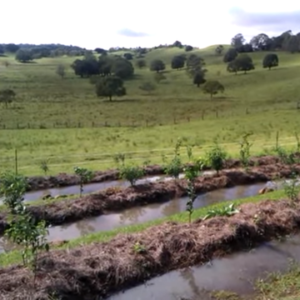
Swales

Agro Forestry
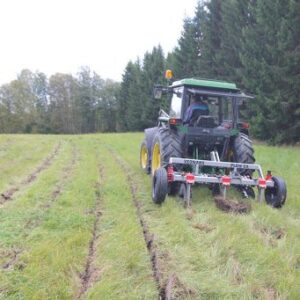
Keyline Ploughing
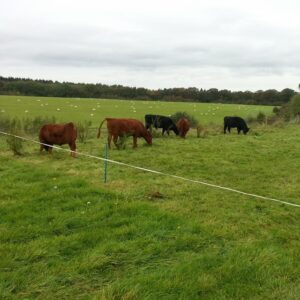
Mob Grazing
Mob Grazing

Mob grazing has been developed by observing how large herd animals lived on the land. The herd stays together for safety and eats vigorously as a group moving slowly across the land.
The advantages of this is that they eat everything in the pasture (not browsing selectively) so everything is trimmed, trampled and covered in manure in 1 day. Weeds are suppressed, trampled grass and manure is returned to the soil.
The herd then moves on and the pasture and soil can recover for a long period before being grazed again. This graph shows the growth curve of grass leys, rotations grazing with a herd keeps the pasture in the prime growth stage for longer, improving it’s health and the health of the soil beneath.
We mob grazed our small herd for a number of years and in the future Kevin will rotate stock around segmented pastures.
Keyline Ploughing and Swales
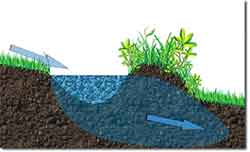
A swale slows run-off water as it travels down a slope and allows more to permeate in to the soil. The excavation is made along a contour line with the soil being deposited on the down hill side of the excavation.
This is then planted up with trees or deep routed plants. We also plan to construct some swales that will hold water in them (either with a lining or using puddled clay) so that we have water for irrigation.
We excavated swales in some of our fields and planted the berm with trees, these now provide a superb source of food for birds of prey, they slow the water run off and now the trees are becoming established will create wind breaks and changing eco systems
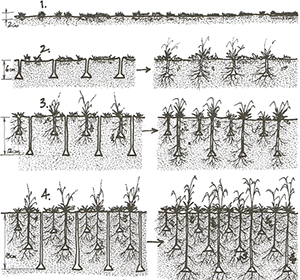
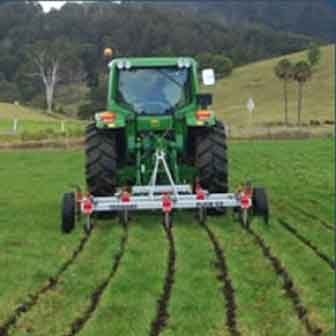
The images show a keyline plough being used and a cross section of what the plough does under the surface. The plough is not used to turn the soil over, but it opens up the soil allowing air and plant roots to penetrate deeper in to compacted soil. As can be seen in the second diagram this brings dramatic improvements to the growth of the sward which then opens up the soil further and improves drainage. The plough is also used to improve water retention on the land by either ploughing along a contour line, or slightly off contour when going on to a ridge to drain water up a ridge not down in to a valley.
We had a key line plough and used it for a while, unfortunately our soil is full of flints which the plough would pull up across the field, so we eventually decided the benefit was less than the downside.
Compost
Composting is a way of speeding up the natural process of nature. Our fertile soils have been built over thousands of years of through the slow decay of organic matter deposited on the ground, such as leaves, plant matter, branches and manure. In autumn and winter plants and trees shed leaves or die back and natures recyclers break down this bounty and return it to the soil.
We can speed up this process and reduce what we put in our bins by composting a huge amount of waste. I recently went on an excellent course run by Richard Higgins based on the scientific research of Sir Albert Howard.
Richard has refined this further to produce unbelievably refined and nutritional compost in just 90 days. The system has been proven in the aftermath of the Haiti earthquake to destroy all pathogens in human waste making it safe to return to the soil as compost.
The key elements to this process are :
- The balance and mixing of the constituent parts.
- The inoculation of the pile
- The maintaining of initial temperatures
- Correct moisture levels
- Air – without air the decomposition becomes an-aerobic (this is when you get nasty smells)
We have larger windrow piles outside and we are trialling a box system inside the green house, by composting in the green house in an insulated box we hope to keep the temperature high enough to start the process (below 5 degrees centigrade the reaction won’t start) and that once the temperature in the box builds it will warm the green house.
We are using a mixture of straw from the animals bedding, hedge cuttings (mulched), leaf fall, horse manure (mixed to a slurry with lake water) green kitchen waste from the house, weeds and other green cuttings, wood ash, crushed biochar.
The compost is used in our vegetable beds and once we have perfected the process we hope to be making enough to start spreading it on the fields.
Agro Forestry
Agro forestry is the combining of trees within the pasture or arable fields. Since the 1940’s trees and hedge rows have been removed from agricultural land at an alarming rate. In Permaculture there is a great deal of evidence that diversity and productivity are greatest when we have an ‘edge effect’, trees and hedge rows produce that edge. We plan to combine our tree and hedge planting with our keyline water retention and distribution, this further increases the edge effect.
The benefits that we anticipate from planting new trees and hedges in rows with our pasture in between are:
- Wind Breaks – Providing shelter for our livestock.
- Increased aeration of soil – Tree roots go deeper and then they die this increase aeration
- Mineral accumulation – Trees bring valuable minerals to the surface
- Bio Diversity – Trees provide shelter and habitat for birds, small mammals and insects creating a more sustainable environment.
- Fodder for Animals – Many trees and hedges can be eaten by animals for food.
- Crop – Trees can provide fruits, nuts and berries for us and wildlife.
- Wood and biomass – The wood can be harvested for wood or fuel.
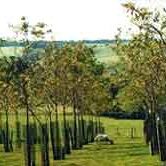
Permaculture
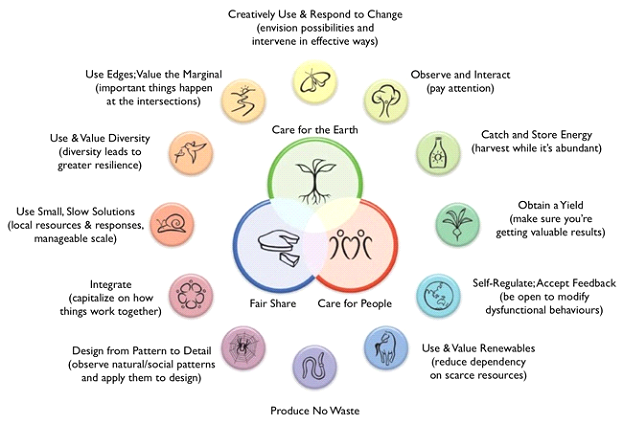
Permaculture is a design system for sustainable living created by Bill Mollison and David Holmgren. We try to work to the Permaculture ethics and apply the 10 principals as we use strategies and techniques devised for sustainability. The ethics and principals are shown here:
Permaculture-Diagram
Nigel has completed a Permaculture design course and examples of how we implement the ethics and principals are:
Care For The Earth
Spraying chemical fertilizer, weed killers and ploughing all damage the soil and eco systems, so we do not do any of these, preferring a holistic approach to soil regeneration.
Observe and Interact
Before taking any actions on our land we observe what is happening, where water collects and runs, what grows where naturally, what birds and insects we have and where we have different micro climates. This helps us plan before we interact.
Catch and Store Energy
We have installed Solar panels and a wind turbine. We harvest rainwater in tanks and our lake and we are planning to build further ponds and irrigation ditches and swales to store rainwater. We hope to install ground source heat pumps to provide heating and hot water, which use stored thermal energy.
Use and Value Diversity
Planting trees and hedges increase diversity, installing water systems increase diversity, our holistic grazing and planting wildflowers increases diversity. We follow our cattle in the fields with free ranging chickens and use our pigs for ploughing, providing diversity of livestock.
The principals and ethics provide great inspiration and solutions to problems.
Our Holistic Goal
By treating our land as a holistic system we are trying to create a virtuous circle of life, a sustainable system that is not reliant on energy, chemicals or inputs from far away. Achievement of this goal is some way off in the future but as per another Permaculture principal, using small slow solutions is better than quick fixes.
Our Holistic Goal is to create a bio diverse and sustainable natural environment for us, our livestock and the visitors to our cottages to enjoy, to produce healthy nutritious food with involvement, interaction and education of our local community.
Holistic planning and management involves testing all your actions against your goal. By checking that the action, intervention or expenditure will move you closer to and not further from your goal we have a process for driving our decisions and actions towards our desired outcome.
By viewing our farm as a holistic part of a larger environment and continually testing decisions we can ensure we make the best use of the resources available to us achieve our goals.